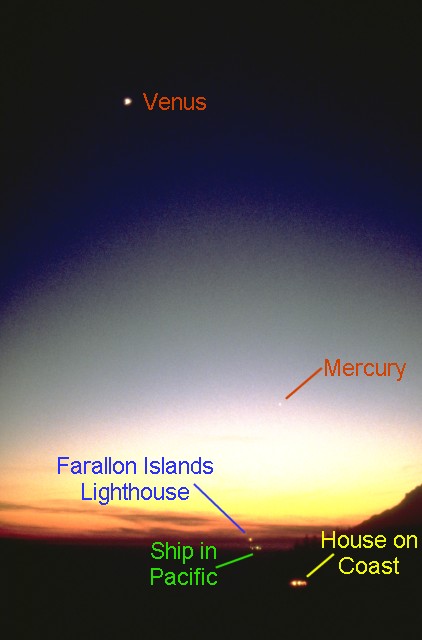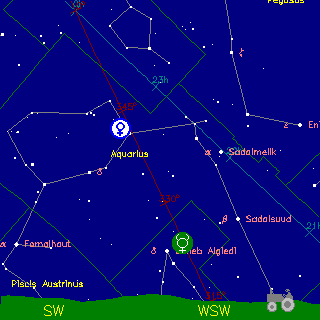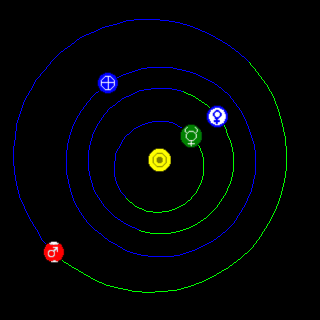|
|
The Three Inner Planets
by John Walker |
|

| Venus (above) and Mercury (below), photographed from Muir Beach, California in the United States on January 24, 1988. |
|
|
The Three Inner Planets
by John Walker |
|

| Venus (above) and Mercury (below), photographed from Muir Beach, California in the United States on January 24, 1988. |
Every now and then, one of those magical moments for astronomical photography comes by, you're fully prepared for it, in the right place at the right time, with camera and appropriate optics at hand, and it doesn't rain! The above shot represents one of those rare occasions in my own life.
Most people haven't ever seen the planet Mercury, at least knowingly. I'm a reasonably dedicated, albeit perennially time-constrained, amateur astronomer who was about to turn 40 without having seen it until the evening I took this picture. Mercury is plenty bright; at maximum it's brighter than any star in the sky and near favourable maximum elongations (times at which Mercury is farthest from the Sun as viewed from Earth, and hence most easily observed) it's brighter than a zero magnitude star such as Vega; brighter than Saturn ever gets.
No, what makes Mercury difficult to spot is its elusiveness. It orbits so close to the Sun that even when the Earth and Mercury are ideally aligned in their orbits and Mercury is at aphelion, Mercury is never more than 27°45' from the Sun. Observing Mercury with the unaided eye, then, is something confined to dawn and twilight hours when the glare of the rising or setting Sun inevitably interferes with observation. Further, Mercury orbits the Sun in only 88 days, which means its position in the sky shifts rapidly; a favourable apparition doesn't last for long.
At the time I took this picture I was living in Muir Beach, a small community of 700 on the west coast of California north of San Francisco. Muir Beach offers spectacular views of San Francisco, the ever-changing Pacific ocean, the Farallon islands, and the rolling hills north of the Golden Gate…when it's clear. The latter is, for an amateur astronomer, the catch. Muir Beach, like most of the coast of Northern California, is shrouded in fog for most of the year except for those occasions in the winter when it is pounded by violent wind and rainstorms. Some folks in Muir Beach spend as much on caulk every year as they do to heat their houses. In the summer the fog often burns off in the middle of the day, but that doesn't do an astronomer much good unless you're willing to confine your observations to a single very bright nearby star, the Moon when it's up, and when conditions are right, Venus.
In Muir Beach, when it comes to clear skies around sunset, December and January are about it, and iffy toward the start and end of that two-month period. When I read of a favourable apparition of Mercury in January of 1988 for northern hemisphere observers in Sky & Telescope magazine, I made a mental note to be ready to observe and photograph that elusive planet. After all, I'd seen every other planet excepting Pluto by the time I turned fifteen—here was an excellent chance to add number eight to my life list before hitting the big four-zero. (No, now that you ask, I still haven't seen Pluto, and I'm now incrementing digits to the right of a five.)
On January 26th, 1988 Mercury reached maximum elongation 18.5° east of the Sun at a magnitude of -0.3. While of modest angular separation from the Sun, this was about as bright as Mercury gets at elongation and in January, near the solstice, the angle of the ecliptic to the horizon increases the interval between the time of sunset and Mercury's disappearance below the horizon. As an extra added attraction, Venus was also prominent in the evening sky at the time, advancing toward its own greatest elongation on April 3rd, 1988, and would be in the same field of view as Mercury.
So, a little before 18:00 local (Pacific Standard) time on Sunday, January 24th, 1988: two days before Mercury's maximum elongation, I cast my gaze into the twilight in the west-southwest direction where Venus was burning as a brilliant sunward beacon, and there it was—Mercury, white and bright, punching through the crepuscule—celestial quicksilver reflecting sunlight ten times more brilliant than terrestrial high noon.
Having anticipated this view, I had my camera at hand, an already venerable 1975 vintage Nikkormat (which would later capture images of Comet Hale-Bopp in 1997 and the 1999 solar eclipse, and no doubt others in the future), loaded with Kodak Ektachrome 400 film. Fixed to the camera was a Nikon 50mm f/1.4 lens (the only one I owned at the time) opened to its full f/1.4 aperture. (This was a mistake, and dumb. Off-axis performance of this lens at full aperture is poor, as I learned two years earlier in Australia photographing Halley's Comet. Some of the shots I took of the southern sky included Mars toward the edge of the frame, and the “red potato” taught me that unless extreme low light performance is required, you get a lot more out of this chunk of glass if you stop it down to f/4 or smaller). With 400 speed film [carefully chosen on the basis that “I already had a roll in there”], there's no earthly reason I couldn't have stopped down the lens and captured a much better image of Venus. It's kind of cool that Venus looks like a crescent if you zoom in on it, but it's totally bogus; what you're seeing is purely an optical artefact of this fast lens toward the edge of the field—at this scale Venus is, in reality, a point source.)
Anyway, here was an opportunity to snap a portrait of the three innermost worlds of the solar system (including the one I was standing on, in the foreground, illuminated by the fading twilight of their common primary). I shot a number of slides with a variety of exposure times, and selected the image above as the best. I did not record the exposure time, and at this remove it is impossible to precisely determine. However, given the known brightness of Venus and the altitude of the Sun one could estimate it if you're so inclined; I'm not.
 Your Sky's
Horizon View
provided the chart at left which shows the horizon in the
direction of the photo at the time it was taken, with a rather
wider (45°) field of view than that afforded by the 50 mm focal length
lens used on the camera. This chart shows clearly how Venus and
Mercury, like all major planets with the exception of Pluto (if
you deem it a major planet) orbit close to the ecliptic—the
plane in which Earth orbits the Sun. In
January the ecliptic is steeply inclined to the horizon at
sunset for observers in northern latitudes, and even
a modest elongation of Mercury places it well above the horizon after
sunset. Scroll back to the original photo and note how the
ecliptic, defined by a line drawn through Venus and Mercury, points
right back to the centre of the glow of the recently set Sun.
Your Sky's
Horizon View
provided the chart at left which shows the horizon in the
direction of the photo at the time it was taken, with a rather
wider (45°) field of view than that afforded by the 50 mm focal length
lens used on the camera. This chart shows clearly how Venus and
Mercury, like all major planets with the exception of Pluto (if
you deem it a major planet) orbit close to the ecliptic—the
plane in which Earth orbits the Sun. In
January the ecliptic is steeply inclined to the horizon at
sunset for observers in northern latitudes, and even
a modest elongation of Mercury places it well above the horizon after
sunset. Scroll back to the original photo and note how the
ecliptic, defined by a line drawn through Venus and Mercury, points
right back to the centre of the glow of the recently set Sun.
When I shot this image, I was intrigued to see the lights of a ship, outbound across the Pacific from San Francisco, on the ocean in the foreground. Above its lights was the periodic flash of the lighthouse on the southeast Farallon Island. I'd say this is a familiar sight for Muir Beach residents, but that doesn't account for the fog…. We're talking serious depth of field here: Venus and Mercury are both about one astronomical unit (the average distance from the Earth to the Sun) from the Earth as is, by definition, the Sun (okay, in late January, we're still close to perihelion, but the Earth's orbit is so close to circular it's negligible at this scale). The lighthouse on the Farallon Islands is about 36 kilometres southwest of San Francisco; viewed from Muir Beach, it is to the south-southwest. The lights at the bottom of the frame are those of a house closer to the coast than mine—about 200 metres in the foreground.
 Let's slip the surly bounds and look at this event from on
high—a couple of astronomical units above the Sun, courtesy
of Solar System Live. It's
evident from this picture that the geometry for viewing Venus
and Mercury from Earth was excellent—yes, it could have
been better were the Earth little further along its
orbit, perpendicular to the line defined by the Sun,
Mercury, and Venus, but you can't have everything and
if you do, you'll probably be clouded out!
Let's slip the surly bounds and look at this event from on
high—a couple of astronomical units above the Sun, courtesy
of Solar System Live. It's
evident from this picture that the geometry for viewing Venus
and Mercury from Earth was excellent—yes, it could have
been better were the Earth little further along its
orbit, perpendicular to the line defined by the Sun,
Mercury, and Venus, but you can't have everything and
if you do, you'll probably be clouded out!
Note that at the time of this apparition, not only was the geometry of the Earth and Mercury suboptimal, but Mercury was closer to perihelion than aphelion, which further reduced its angular elongation from the Sun.
For custom predictions of the visibility of Mercury at
maximum elongations for any year from any observing site,
including finder charts showing the position of Mercury
at dawn or sunset on the day of the elongation, please
visit the
Mercury Chaser's Calculator.
The Calculator page requires a browser which supports JavaScript,
as it performs extensive calculations in that language to
determine the relative positions of the Sun, Earth and
Mercury.
|
|
All images in this document are in the public domain and may be used in any manner without permission, restriction, attribution, or compensation. Back links to The Three Inner Planets are welcome.